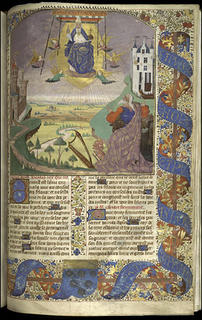
If you're in NYC anytime soon, it might be worth your time to visit the new illuminated manuscripts exhibit, many which have rarely or never been seen in public:
In many instances the show is a kind of glorious push-pull among text, decorated initials, discrete images and scrolling borders. Their tensions are most spectacular in a three-volume version of Guyart de Moulins's historical Bible, made in Paris in the 1330's with illuminations by five different artists. One volume is open to a panoramic image that shows King David praying to God from a canopied throne held aloft by angels. The world, spreading out beneath him, is seen from a God's-eye view, suggesting that David is nearly level with the Lord. But in many instances, drawing of a surprisingly offhand nature, rather than painting, does the illuminating. For example, on the frontispiece of the Harkness Gospels from 9th- or 10th-century Brittany, the four winged Evangelists and Christ in Majesty are indicated in skillful but almost cursory strokes that resemble pale watercolor. Even more cryptic is a nearby page from an early-14th-century English picture-book Apocalypse, in which an angel, descending to earth clothed as a cloud, is depicted as a pair of undulating lavender bands with a head and wings. It is not too far from this to the fevered visions of William Blake.
In several examples of "glossed" Gospels, we see what is more or less the birth of the footnote. The texts of the four Evangelists are annotated (or glossed) in smaller script that sometimes all but commandeers the page. For clarity, paragraphs are marked with little nodes in red or blue, or delineated by feathery lines that trail into the margins like delicate plants putting down roots.
The details are here.

No comments:
Post a Comment